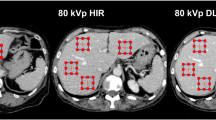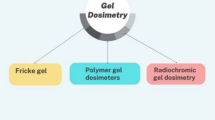Abstract
To assess the practical feasibility and effectiveness of real-time magnetic resonance (MR) temperature monitoring for the radiofrequency (RF) ablation of liver tumours in a clinical setting, nine patients (aged 49–87 years, five men and four women) with one malignant tumour (14–50 mm, eight hepatocellular carcinomas and one colorectal metastasis), were treated by 12-min RF ablation using a 1.5-T closed magnet for real-time temperature monitoring. The clinical monopolar RF device was filtered at 64 MHz to avoid electromagnetic interference. Real-time computation of thermal-dose (TD) maps, based on Sapareto and Dewey’s equation, was studied to determine its ability to provide a clear end-point of the RF procedure. Absence of local recurrence on follow-up MR images obtained 45 days after the RF ablation was used to assess the apoptotic and necrotic prediction obtained by real-time TD maps. Seven out of nine tumours were completely ablated according to the real-time TD maps. Compared with 45-day follow-up MR images, TD maps accurately predicted two primary treatment failures, but were not relevant in the later progression of one case of secondary local tumour. The real-time TD concept is a feasible and promising monitoring method for the RF ablation of liver tumours.




Similar content being viewed by others
References
Choi D, Lim HK, Rhim H et al (2007) Percutaneous radiofrequency ablation for early-stage hepatocellular carcinoma as a first-line treatment: long-term results and prognostic factors in a large single-institution series. Eur Radiol 17:684–692
Gillams AR, Lees WR (2008) Five-year survival following radiofrequency ablation of small, solitary, hepatic colorectal metastases. J Vasc Interv Radiol 19:712–717
Raman SS, Lu DS, Vodopich DJ, Sayre J, Lassman C (2000) Creation of radiofrequency lesions in a porcine model: correlation with sonography, CT, and histopathology. AJR Am J Roentgenol 175:1253–1258
Solbiati L, Ierace T, Tonolini M, Cova L (2004) Guidance and monitoring of radiofrequency liver tumor ablation with contrast-enhanced ultrasound. Eur J Radiol 51(Suppl):S19–S23
Vilana R, Bianchi L, Varela M et al (2006) Is microbubble-enhanced ultrasonography sufficient for assessment of response to percutaneous treatment in patients with early hepatocellular carcinoma? Eur Radiol 16:2454–2462
Dromain C, de Baere T, Elias D et al (2002) Hepatic tumors treated with percutaneous radio-frequency ablation: CT and MR imaging follow-up. Radiology 223:255–262
Sapareto SA, Dewey WC (1984) Thermal dose determination in cancer therapy. Int J Radiat Oncol Biol Phys 10:787–800
Puccini S, Bar NK, Bublat M, Kahn T, Busse H (2003) Simulations of thermal tissue coagulation and their value for the planning and monitoring of laser-induced interstitial thermotherapy (LITT). Magn Reson Med 49:351–362
Bohris C, Schreiber WG, Jenne J et al (1999) Quantitative MR temperature monitoring of high-intensity focused ultrasound therapy. Magn Reson Imaging 17:603–610
Vigen KK, Jarrard J, Rieke V et al (2006) In vivo porcine liver radiofrequency ablation with simultaneous MR temperature imaging. J Magn Reson Imaging 23:578–584
Seror O, Lepetit-Coiffé M, Le Bail B et al (2008) Real time monitoring of radiofrequency ablation based on MR thermometry and thermal dose in the pig liver in vivo. Eur Radiol 18:408–416
Bruix J, Sherman M, Llovet JM et al (2001) Clinical management of hepatocellular carcinoma. Conclusions of the Barcelona-2000 EASL conference. European Association for the Study of the Liver. J Hepatol 35:421–430
Livraghi T, Lazzaroni S, Meloni F (2001) Radiofrequency thermal ablation of hepatocellular carcinoma. Eur J Ultrasound 13:159–166
Peters RD, Hinks RS, Henkelman RM (1998) Ex vivo tissue-type independence in proton-resonance frequency shift MR thermometry. Magn Reson Med 40:454–459
Quesson B, de Zwart JA, Moonen CT (2000) Magnetic resonance temperature imaging for guidance of thermotherapy. J Magn Reson Imaging 12:525–533
Goldberg SN, Grassi CJ, Cardella JF et al (2005) Image-guided tumor ablation: standardization of terminology and reporting criteria. Radiology 235:728–739
Boss A, Rempp H, Martirosian P et al (2008) Wide-bore 1.5 Tesla MR imagers for guidance and monitoring of radiofrequency ablation of renal cell carcinoma: initial experience on feasibility. Eur Radiol 18:1449–1455
Seror O, N’Kontchou G, Ibraheem M, Ajavon Y, Barrucand C, Ganne N, Coderc E, Trinchet JC, Beaugrand M, Sellier N (2008) Large (>or=5.0-cm) HCCs: multipolar RF ablation with three internally cooled bipolar electrodes—initial experience in 26 patients. Radiology 248:288–296
Weidensteiner C, Kerioui N, Quesson B et al (2004) Stability of real-time MR temperature mapping in healthy and diseased human liver. J Magn Reson Imaging 19:438–446
Cernicanu A, Lepetit-Coiffé M, Roland J, Becker CD, Terraz S (2008) Validation of fast MR thermometry at 1.5 T with gradient-echo echo planar imaging sequences: phantom and clinical feasibility studies. NMR Biomed 21:849–858
Acknowledgements
Authors would like to acknowledge grant supports provided by the Conseil Régional d’Aquitaine and The Ligne Nationale Contre le Cancer.
Author information
Authors and Affiliations
Corresponding author
Rights and permissions
About this article
Cite this article
Lepetit-Coiffé, M., Laumonier, H., Seror, O. et al. Real-time monitoring of radiofrequency ablation of liver tumors using thermal-dose calculation by MR temperature imaging: initial results in nine patients, including follow-up. Eur Radiol 20, 193–201 (2010). https://doi.org/10.1007/s00330-009-1532-1
Received:
Accepted:
Published:
Issue Date:
DOI: https://doi.org/10.1007/s00330-009-1532-1




